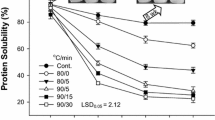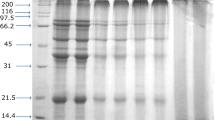Abstract
Effects of drying methods on hydrophobicity, solubility, water hydration capacity, viscosity, and adhesive strength of soy protein isolates treated with Na2SO3 (disulfide bond-cleaving agent) were investigated. Treatment with 0.1 M Na2SO3 resulted in 28% decrease in disulfide linkages in soy proteins. While hydrophobicity and solubility increased, waterholding capacity of soy proteins decreased due to the treatment. Spray-dried product had higher hydrophobicity, solubility, water hydration capacity, and viscosity compared to freeze-dried product. Adhesive strength on wood increased due to modification; however, the drying process had no significant effect on this property. Viscosities of spray-dried product, freeze-dried product, and unmodified soy proteins were 2,200, 100, and 240 cP, respectively. Fluorescence spectra of spray-dried and freezedried products indicated a partial folding of molecules around tryptophan. High-performance liquid chromatographic elution profiles showed no significant differences in molecular sizes of unfolded molecules of spray-dried and freeze-dried proteins.
Similar content being viewed by others
References
Lambuth, A.L., Soybean Glues, in Handbook of Adhesives, 2nd edn., edited by I.S. Keist, Van Nostrand Reinhold, New York, 1977, pp. 172–180.
Myers, D.J., Industrial Applications for Soy Protein and Potential for Increased Utilization, Cereal Foods World 38:355–360 (1993).
Hettiarachchy, N.S., U. Kalapathy, and D. Myers, Alkali-Modified Soy Proteins with Improved Adhesive and Hydrophobic Properties, J. Am. Oil Chem. Soc. 72:1461–1467 (1995).
Kalapathy, U., N.S. Hettiarachchy, D. Myers, and K.C. Rhee, Alkali-Modified Soy Proteins: Effect of Salts and Disulfide Bond Cleavage on Adhesion and Viscosity, Ibid.:1063–1066 (1996).
Kinsella, J.E., Functional Properties of Soy Proteins, Ibid.:242–258 (1979).
Kinsella, J.E., S. Damodaran, and B. German, Physicochemical and Functional Properties of Oilseed Proteins with Emphasis on Soy Proteins, in New Protein Foods, edited by A.M. Altschul and H.L. Wilcke, Academic Press, Inc., New York, 1985, pp. 113–161.
Kella, N.K.D., S.T. Yang, and J.E. Kinsella, Effect of Disulfide Bond Cleavage on Structural and Interfacial Properties of Whey Proteins, J. Agric. Food Chem. 37:1203–1210 (1989).
German, J.B., T.E. O’Neil, and J.E. Kinsella, Film Forming and Foaming Behavior of Food Proteins. J. Am. Oil Chem. Soc. 62:1358–1366 (1985).
Kalapathy, U., N.S. Hettiarachchy, D. Myers, and M.A. Hanna, Modification of Soy Proteins and Their Adhesive Properties on Woods, Ibid.:507–510 (1995).
Hayakawa, S., and S. Nakai, Relationships of Hydrophobicity and Net Charge to the Solubility of Milk and Soy Proteins, J. Food Sci. 50:436–491 (1985).
Franzen, K.L., and J.E. Kinsella, Functional Properties of Succinylated and Acetylated Soy Protein, J. Agric. Food Chem. 24:788–795 (1976).
Gornall, A.G., J. Bardawill, and M.M. David, Determination of Serum Proteins by Means of the Biuret Reaction, J. Biol. Chem. 177:751–766 (1949).
Quinn, J.R., and D. Paton, A Practical Measurement of Water Hydration Capacity of Protein Materials, Cereal Chemistry 56:38–39 (1979).
Beveridge, T., S.J. Toma, and S. Nakai, Determination of SH and SS Groups in Some Food Proteins Using Elman’s Reagent, J. Food Sci. 39:49–51 (1974).
General Linear Models Procedure, The SAS System (1992), SAS Institute, Cary, NC.
Kato, A., and S. Nakai, Hydrophobicity Determined by a Fluorescence Probe Method and Its Correlation with Surface Properties of Proteins, Biochim. Biophys. Acta 624:13–20 (1980).
Phillips, L.G., D.M. Whitehead, and J. Kinsella, Modification Reactions and Protein Structure, in Structure-Function Properties of Food Proteins, Academic Press, Inc., San Diego, 1994, p. 211.
Labuza, T.P., and G.C. Busk, An Analysis of the Water Binding in Gels, J. Food Sci. 44:1379–1385 (1979).
Arrese, E.L., D.A. Sorgentini, J.R. Wagner, and M.C. Anon, Electrophoretic, Solubility, and Functional Properties of Commercial Soy Protein Isolates, J. Agric. Food Chem. 39:1029–1032 (1991).
Author information
Authors and Affiliations
About this article
Cite this article
Kalapathy, U., Hettiarachchy, N.S. & Rhee, K.C. Effect of drying methods on molecular properties and functionalities of disulfide bond-cleaved soy proteins. J Amer Oil Chem Soc 74, 195–199 (1997). https://doi.org/10.1007/s11746-997-0123-z
Received:
Accepted:
Issue Date:
DOI: https://doi.org/10.1007/s11746-997-0123-z




